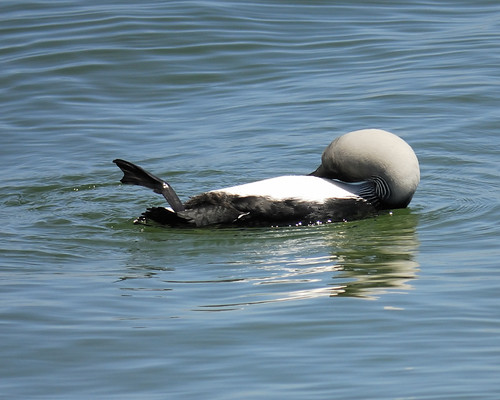tags: Pacific Loon, Pacific Diver, Gavia pacifica, Gavia arctica, birds, mystery bird, bird ID quiz
[Mystery bird] Pacific Loon, known in Europe as the Pacific Diver, Gavia pacifica (formerly lumped with Gavia arctica), photographed in Monterey Bay, California. [I will identify this bird for you in 48 hours]
Image: Joseph Kennedy, 7 May 2010 [larger view].
Nikon D200, Kowa 883 telescope with TSN-PZ camera eyepiece 1/750s f/8.0 at 1000.0mm iso400.
Please name at least one field mark that supports your identification.
This elegant mystery bird's common and scientific names have a convoluted etymology and history. Can you tell me how it got its names?
Depending upon whom you talk to, "loon" refers either to the bird's clumsy movements on land [Old Norse term lÅmr, which may mean "lame ones"] or to its distinctive wailing calls. Related words that express a ponderous, somewhat clumsy or lumbering quality -- e.g. "lament". The Scots word "loon" has been influenced by the Middle English loun, meaning "crazy person". The etymology for "lunatic" is thought to be a reference to the birds' haunting, high-pitched yodelling cry, which is often heard in moonlit nights.
Pacific Loon, Gavia pacifica, calls:
Listen to a BirdNote Radio report about the call of the closely-related Common Loon, Gavia immer:
Learn more about BirdNote Radio.
- Log in to post comments


Mah tummy be itcha! That's a Pacific Loon is it not? I'm not sure there is consensus on where the common name Loon came from. Probably from the old Norse word lÅmr which means Lame. However, this root word can either be in reference to the birds inability to walk on land, thus being lame or the lamenting call of the loon. Of course, speaking of the call, it is also a wild call like that of a lunatic or loon. As far at the scientific name there has been a lot of back and forth but one thing is for certain. I'm glad the proposed, and horrible, Urinatoridae genus didn't stick. Holy hell that would be a terrible genus.
You mean it wasn't named after the coin???
Our loons may have just hatched this year's chick. We are anxiously awaiting confirmation.
Twin Cities Naturalist: what field marks led you to your ID?
Greg: well, if it's hatched, i can hardly wait to see the baby pictures!
I've got a couple, GrrlScientist, but I'll hold off until we hear back from TCN.
red-throated loon winter plumage?
Looks like a loon to me - from the watery locale as well as the neck striping. Pacific loon if it was taken in CA (whitish head helps as me).
I always thought it was a "loon" because its call sounds like a "loon"-atic - but the internet says this is wrong. I like that explanation better than the "lame" one outlined by Twin Cities Naturalist above...
"helps as me" = "helps as well"
D'oh!
I'm going to guess the long-tailed duck; formerly known as oldsquaw until the name became politically incorrect. Don't have a line on anything unusual about 'clangula hyemalis' though...
Two countries separated by the same language! It's a DIVER, folks.
Among the other convolutions, this species was only split off from it's old-world counterpart quite recently. The straight line dividing the black flanks from the white underparts distinguishes it from the other diver it used to be lumped with.
Maybe so, Adrian; but I can't see my Canadian friends trading in their loonies for divers. ;>)
I think it's a cormorant. Long slender head and neck.
http://aknhp.uaa.alaska.edu/LoonWatch/sounds/Common%20Loon.mp3 OOps, it's a loon, the white stripes along the throat. I am corrected.
http://t0.gstatic.com/images?q=tbn:rQlIPZkHIlhfaM:http://aknhp.uaa.alas…
Pacific loon: black and white loon markings, but white head--and in California. Name? I had always heard that "loon" was because of the wild, laughing call.
I'm more used to hearing loons than seeing them, but this sure looks like Sibley's pictures of Pacific and Arctic loons in breeding color, perhaps a young one. Which one? The posture makes it a bit difficult to see the apparently fine distinctions, (is that a "pale gray nape showing at great distance (P)" or a "slightly darker nape (A)". Range leans towards Pacific, but doesn't rule out Arctic. Is that "sharp contrast and straight border on neck(P) or "white lines on neck more obvious (A)"
Despite a hint of a "white tuft at rear flank (A)", I'm going to intepret Sibleys' somewhat confusing final paragraph that "other species may roll over to expose white belly, often when preening" to mean that Arctic's don't. So I vote Pacific Loon, Gavia pacifica (aka Pacific Diver for Adrian).
As for the history of the names... I'll align myself with Keith Stewart Thomson's view ( http://bit.ly/9yNwGA ) that "loon" comes to us, via Scandanavian sources, from words related to "lame" and refers to the diver's poor perambulatory abilities rather than to the lunatic sound of its call. The wikipedia "loon" article has a good discussion of the convoluted history of the latin names, including mistaken fossil records, the 18th century transference of "Gavia" from ducks to loons, and the even more recent decision to separate Gavia Pacifica from Gavia Arctica, making our task more difficult.
Sorry, didn't include the field marks. I was going by the gray neck and the stripes on the throat. I'm not as familiar with the Arctic loon though.
PH -- I wouldn't interpret Sibley to mean that Arctic's don't roll over, rather simply to make sure that that's not what you're seeing. On the other hand, it appears that the dividing line between black and white on the flanks is straight -- the tuft on an arctic should show up as a curve in that line.